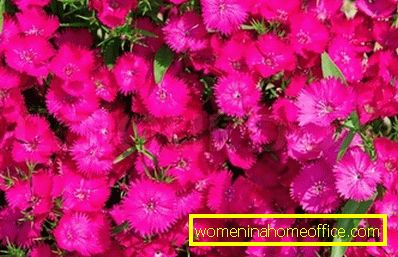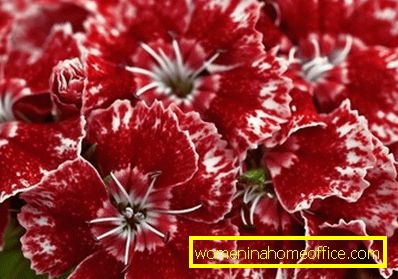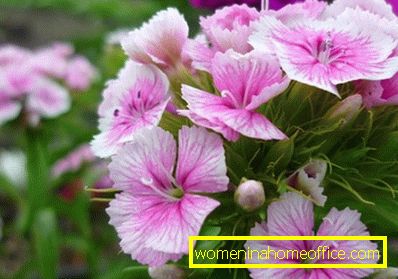Turkish carnation
For some, the carnation is the main association with the memorable May date for the country, for someone it is the constant companion of mourning. But it must be admitted that this is a cold-resistant plant with double petals, collected in inflorescences, and sometimes with a fancy color, blooming only a year after sowing, is attractive for an amateur gardener and for a landscape designer if it’s about filling the plot for several years .
Turkish carnation: growing from seed to seedlings


The germination of Turkish clove seeds depends on how well the preparatory stages will be carried out. Despite its unpretentiousness, the flower is not immediately amenable to cultivation. Practicing gardeners recommend that in order to speed up the germination of seeds, first prepare the ground: mix the garden soil with sand, moisten it and tighten the film. After 2-3 days, the earth is loosened and moistened again, after which it is covered again with a film. After 2 days the procedure is repeated. After 7-8 days, the film can be removed, the soil can be loosened again, moistened, and then the sowing of the Turkish carnation should begin. The seeds themselves do not need to soak.
Sowing is performed as follows: the entire surface of the substrate is covered with grooves, between which 3-3.5 cm of distance is maintained, the depth of the grooves should not exceed 1.5 cm. They should be treated with a solution of potassium permanganate to disinfect the soil. Seeds are scattered into the grooves in a thin strip, after which they are covered with a layer of the same soil or coarse sand. Seedlings containers are also tightened with a film, after which they are removed to a shaded but warm place. Flowers do not like the heat, but the temperature of the air is not lower than 23 degrees for them, while germination is expected. Since they usually hatch quickly enough, and it’s not worth holding a seedling in an apartment for too long, the dates for planting a Turkish nail for seedlings are the end of May or the beginning of June, depending on the weather conditions in your region. In the southern regions, it is possible and earlier sowing - in early May.
Most often, the sprouts begin to hatch by the end of the 2nd week, after which they may require thinning, if germination of the seeds was high. Some gardeners specially distribute the seeds when sowing so that there is 2-3 cm between them. The distance, but not always, such a move is justified and does not lead to an almost bald ground in a container with seedlings. A pick on individual cups is made at the beginning of the 4th week from the time of sowing, and if the outside air temperature allows, seedlings can be planted immediately across the plot in open ground. But after that, you still have to cover this area with a film so as not to overcool the shoots in the dark. At the same time, the transplant itself is necessarily carried out in the evening, when the sun shows the least activity. The land on the plot, as well as before sowing, is treated with potassium permanganate.
How to plant in a garden?


It is necessary to plant the carnation on the site so that the seedling to the seedling is 5-7 cm, and if you are already working with adult specimens, then all are 13-15 cm. At the same time, after the flower is 1.5-2 months, the film can be removed from it. Or, if the summer turns out to be hot, it can be removed earlier, but above the carnation it is worthwhile to create a fabric canopy that will cast a shadow on it at the peak of solar activity (from 11 to 17 h): the plant tolerates heat very badly. But most often practicing gardeners plant a Turkish carnation on the site in August, when the heat is declining, or in early September. However, if you plant the flower closer to frost, the holes in which the seedlings are lowered cannot be moistened. And with the promise of near cold weather, the soil around the root is warmed with leaves and grass, or a covering material.
Ideally, plant a terry Turkish carnation on the site so that it is in the zone of natural shading, as well as where it will be reliably protected from wind-through. A flower grows well among other ornamental plants, especially tall perennials: Turkish carnation is often used to hide the bare trunks of these plants. In addition, planted quite tightly, the Turkish carnation will not allow the weeds to break through, which, again, is only for the good, since it allows us to do without weeding. The only thing is that the minimum distance of 7-10 cm between carnation seedlings is better preserved so that “natural selection” does not begin, in which some flowers will draw all the nutrients themselves, and some will die from their deficiency.
If it was necessary to moisten the seedlings almost daily, then the adult bushes of the Turkish carnation are enough 1 time in 7-10 days, and 1 time in 5-7 days, if the summer was droughty. The closer the cold, the less often the flower is watered so that sudden frosts in combination with wet soil do not lead to the death of the plant's root system. In addition, it will be necessary to carefully monitor the condition of the carnation during prolonged rains or even after the first rain: if the ground is washed away very strongly, it is necessary to loosen its top layer and pour fresh, dry soil to the bush. In addition, in order to prevent rotting of the roots of the Turkish carnation, lower shoots are necessarily removed, and copper sulfate processing is also carried out.
Peculiarities of growing a terry clove at home


In addition to the basic rules listed above, the condition of the bushes, the abundance of their flowering and other nuances can be affected by several additional factors that a number of amateur gardeners forget, especially if they leave a flower in an apartment.
- Top dressing. Certainly, the Turkish carnation planted on a fertile site, not burdened by the neighborhood with anyone, until next year will find food in the soil. But if it is located in a confined space, the earth is not saturated with nutrients and is not updated on its own. For this reason, several serious flower dressings are carried out: first, in the process of planting, when compost and humus are laid in the hole; then, in summer, when the buds begin to tie, a superphosphate or high-quality potash fertilizer is necessarily applied to the cloves; and after, at the peak of flowering, a portion of superphosphate is repeated. It can be replaced with complex fertilizer for flowers. The following year, the feeding cycle does not begin before flowering, but in spring, at the end of April, and repeats every 21-24 days.
- Left in the apartment Turkish terry carnation should not feel a shortage of light, so it is placed on the balconies or window sills of the south-east or south side. If this is not possible, an additional lamp may be needed, which is produced as soon as the sun leaves the room.
- Before moving the young shoots of carnations to the balcony, they begin to harden: first they just remove the film from the containers for 2-3 hours, then increase this time to 6-8 hours, while keeping the boxes in the room. After 5-7 days, you can begin to set up containers with seedlings on the balcony, also gradually increasing the time of the “walk”.
Subject to all the rules and advice given above, growing a clove in Turkey at home or at the dacha will not pose any problem for you. Do not abuse with watering, monitor the condition of the bushes during the rain, do not introduce nitrogenous fertilizers into the substrate and be sure to shade the bushes on hot days. Turkish carnation does not require more care.